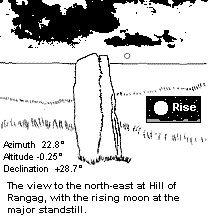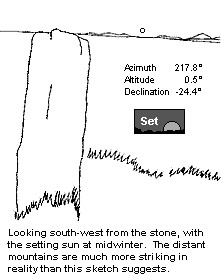
Hill of Rangag, Caithness
Stones
of Wonder
QUICK LINKS ...
HOME PAGE
INTRODUCTION
WATCHING
THE SUN, MOON AND STARS
THE
MONUMENTS
THE
PEOPLE AND THE SKY
BACKGROUND
ARCHAEOASTRONOMY
USING
THE SITE DESCRIPTION PAGES
VISITING
THE SITES
THE
LEY LINE MYSTERY
THE
SITES
ARGYLL
AND ARRAN
MID
AND SOUTH SCOTLAND
NORTH
AND NORTH-EAST SCOTLAND
WESTERN
ISLES AND MULL
Data
DATES
OF EQUINOXES AND SOLSTICES, 1997 to 2030 AD
DATES
OF MIDSUMMER AND MIDWINTER FULL MOONS, 1997 to 2030 AD
POSTSCRIPT
Individual
Site References
Bibliography
Links
to other relevant pages
Contact
me at : rpollock456@gmail.com
Standing Stone ND184452*
 How
to find : From its
juction with the A9 at Latheron, take the A895 north for 11km. You will
see a farm with a large square-sectioned standing stone beside it. Walk
up the track from the farm (heading east) and on following the forest
road into a conifer plantation. The stone is visible on the skyline from
the forest gate, and is about six hundred metres distant - just follow
the road up to it.
How
to find : From its
juction with the A9 at Latheron, take the A895 north for 11km. You will
see a farm with a large square-sectioned standing stone beside it. Walk
up the track from the farm (heading east) and on following the forest
road into a conifer plantation. The stone is visible on the skyline from
the forest gate, and is about six hundred metres distant - just follow
the road up to it.
Best time of year to visit : Major standstill moonrise. Midwinter sunset.
This standing stone, which seems to have been located so as to be visible from a good distance around, still has its horizons open, but they may not last as the trees grow up around the stone!
This menhir is about 1.5 metres high, with its longer axis aligned north-east to south-west.
To the north-east the stone looks over the absolutely flat and featureless bogs of northern Caithness. The bearing is 26.8° and the horizon altitude is -0.25°, which gives +28.7° as the declination, being close to that of the rising winter moon during the major standstill. To watch for the moon over the flat horizon and then see it appear would be a truly memorable experience.
 The
reverse azimuth to the south is 206.8°, which with an altitude of
1.0° produces a declination of -27.3°, which is of no significance.
However, anyone who visits the site on a clear day will immediately notice
the range of mountain peaks which poke up beyond the moorline in striking
prominence just right of the indicated line. This is the range which includes
Scaraben (626m high) and Morven (706m), both of which are in view. They
are 24 kilometres or about 15 miles distant.
The
reverse azimuth to the south is 206.8°, which with an altitude of
1.0° produces a declination of -27.3°, which is of no significance.
However, anyone who visits the site on a clear day will immediately notice
the range of mountain peaks which poke up beyond the moorline in striking
prominence just right of the indicated line. This is the range which includes
Scaraben (626m high) and Morven (706m), both of which are in view. They
are 24 kilometres or about 15 miles distant.
This guide does not generally include sightlines which are not derived from the stones themselves, but it is interesting that there is an obvious gap between the mountains, the middle side of which has a bearing of 217.8° at a horizon height of 0.5°, giving a declination of -24.4°. This is close to the the position of the setting sun at midwinter, which goes down over the gap.